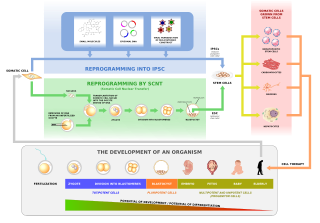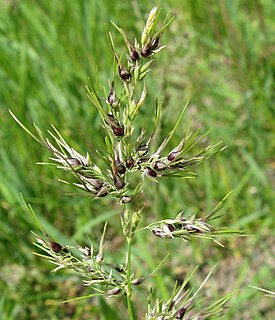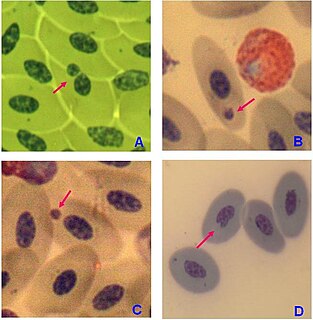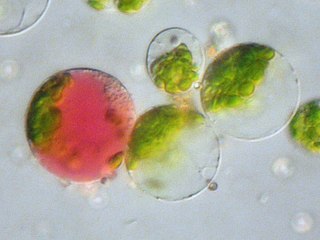Related Research Articles

The cell is the basic structural, functional, and biological unit of all known organisms. Cells are the smallest units of life, and hence are often referred to as the "building blocks of life". The study of cells is called cell biology, cellular biology, or cytology.

In cell biology, the nucleus is a membrane-bound organelle found in eukaryotic cells. Eukaryotes usually have a single nucleus, but a few cell types, such as mammalian red blood cells, have no nuclei, and a few others including osteoclasts have many. The main structures making up the nucleus are the nuclear envelope, a double membrane that encloses the entire organelle and isolates its contents from the cellular cytoplasm; and the nuclear matrix, a network within the nucleus that adds mechanical support, much like the cytoskeleton supports the cell as a whole.

Cloning is the process of producing individuals with identical or virtually identical DNA, either naturally or artificially. In nature, many organisms produce clones through asexual reproduction. Cloning in biotechnology refers to the process of creating clones of organisms or copies of cells or DNA fragments.

Human cloning is the creation of a genetically identical copy of a human. The term is generally used to refer to artificial human cloning, which is the reproduction of human cells and tissue. It does not refer to the natural conception and delivery of identical twins. The possibility of person cloning has raised controversies. These ethical concerns have prompted several nations to pass laws regarding human cloning and its legality.
Nucleus is a Latin word for the seed inside a fruit. It most often refers to:

In botany, apomixis is asexual reproduction without fertilization. Its etymology is Greek for "away from" + "mixing". This definition notably does not mention meiosis. Thus "normal asexual reproduction" of plants, such as propagation from cuttings or leaves, has never been considered to be apomixis, but replacement of the seed by a plantlet or replacement of the flower by bulbils were categorized as types of apomixis. Apomictically produced offspring are genetically identical to the parent plant.

The blood–brain barrier (BBB) is a highly selective semipermeable border of endothelial cells that prevents solutes in the circulating blood from non-selectively crossing into the extracellular fluid of the central nervous system where neurons reside. The blood–brain barrier is formed by endothelial cells of the capillary wall, astrocyte end-feet ensheathing the capillary, and pericytes embedded in the capillary basement membrane. This system allows the passage of some molecules by passive diffusion, as well as the selective and active transport of various nutrients, ions, organic anions, and macromolecules such as glucose, water and amino acids that are crucial to neural function.

In genetics and developmental biology, somatic cell nuclear transfer (SCNT) is a laboratory strategy for creating a viable embryo from a body cell and an egg cell. The technique consists of taking an enucleated oocyte and implanting a donor nucleus from a somatic (body) cell. It is used in both therapeutic and reproductive cloning. In 1996, Dolly the sheep became famous for being the first successful case of the reproductive cloning of a mammal. In January 2018, a team of scientists in Shanghai announced the successful cloning of two female crab-eating macaques from foetal nuclei.

Pyknosis, or karyopyknosis, is the irreversible condensation of chromatin in the nucleus of a cell undergoing necrosis or apoptosis. It is followed by karyorrhexis, or fragmentation of the nucleus. Pyknosis is also observed in the maturation of erythrocytes and the neutrophil. The maturing metarubricyte will condense its nucleus before expelling it to become a reticulocyte. The maturing neutrophil will condense its nucleus into several connected lobes that stay in the cell until the end of its cell life.

Sir John Bertrand Gurdon is a British developmental biologist. He is best known for his pioneering research in nuclear transplantation and cloning. He was awarded the Lasker Award in 2009. In 2012, he and Shinya Yamanaka were awarded the Nobel Prize for Physiology or Medicine for the discovery that mature cells can be converted to stem cells.

Acetabularia is a genus of green algae in the family Polyphysaceae, Typically found in subtropical waters, Acetabularia is a single-celled organism, but gigantic in size and complex in form, making it an excellent model organism for studying cell biology. In form, the mature Acetabularia resembles the round leaves of a nasturtium, is 0.5 to 10 cm tall and has three anatomical parts: a bottom rhizoid that resembles a set of short roots; a long stalk in the middle; and a top umbrella of branches that may fuse into a cap. Unlike other giant unicellular organisms, which are multinucleate, Acetabularia has a single nucleus, located in the rhizoid and allows the cell to regenerate completely if its cap is removed. The caps of two Acetabularia may also be exchanged, even from two different species. In addition, if a piece of the stem is removed, with no access to the nucleus in the rhizoid, this isolated stem piece will also grow a new cap.

Two-hybrid screening is a molecular biology technique used to discover protein–protein interactions (PPIs) and protein–DNA interactions by testing for physical interactions between two proteins or a single protein and a DNA molecule, respectively.

The cochlear nuclear (CN) complex comprises two cranial nerve nuclei in the human brainstem, the ventral cochlear nucleus (VCN) and the dorsal cochlear nucleus (DCN). The ventral cochlear nucleus is unlayered whereas the dorsal cochlear nucleus is layered. Auditory nerve fibers, fibers that travel through the auditory nerve carry information from the inner ear, the cochlea, on the same side of the head, to the nerve root in the ventral cochlear nucleus. At the nerve root the fibers branch to innervate the ventral cochlear nucleus and the deep layer of the dorsal cochlear nucleus. All acoustic information thus enters the brain through the cochlear nuclei, where the processing of acoustic information begins. The outputs from the cochlear nuclei are received in higher regions of the auditory brainstem.

Gene delivery is the process of introducing foreign genetic material, such as DNA or RNA, into host cells. Gene delivery must reach the genome of the host cell to induce gene expression. Successful gene delivery requires the foreign gene delivery to remain stable within the host cell and can either integrate into the genome or replicate independently of it. This requires foreign DNA to be synthesized as part of a vector, which is designed to enter the desired host cell and deliver the transgene to that cell's genome. Vectors utilized as the method for gene delivery can be divided into two categories, recombinant viruses and synthetic vectors.

A micronucleus test is a test used in toxicological screening for potential genotoxic compounds. The assay is now recognized as one of the most successful and reliable assays for genotoxic carcinogens, i.e., carcinogens that act by causing genetic damage and is recommended by the OECD guideline for the testing of chemicals. There are two major versions of this test, one in vivo and the other in vitro.
Cell fusion is an important cellular process in which several uninucleate cells combine to form a multinucleate cell, known as a syncytium. Cell fusion occurs during differentiation of myoblasts, osteoblasts and trophoblasts, during embryogenesis, and morphogenesis. Cell fusion is a necessary event in the maturation of cells so that they maintain their specific functions throughout growth.

Somatic fusion, also called protoplast fusion, is a type of genetic modification in plants by which two distinct species of plants are fused together to form a new hybrid plant with the characteristics of both, a somatic hybrid. Hybrids have been produced either between different varieties of the same species or between two different species.

The existence of frozen soft tissue remains and DNA of woolly mammoths has led to the idea that the species could be recreated by scientific means. Several methods have been proposed to achieve this.
Noori is a female pashmina goat, the first pashmina goat to be cloned using the process of nuclear transfer. Born on 9 March 2012, she is kept at the place of her birth, at the Faculty of Veterinary Sciences and Animal Husbandry, Sher-e-Kashmir University of Agricultural Sciences and Technology of Kashmir, Shuhama, Srinagar in the Indian territory of Jammu and Kashmir.
The Micrantha is a wild citrus from the papeda group, native to southern Philippines, particularly islands of Cebu and Bohol. Two varieties are recognized: small-flowered papeda, locally known as biasong, and small-fruited papeda or samuyao.